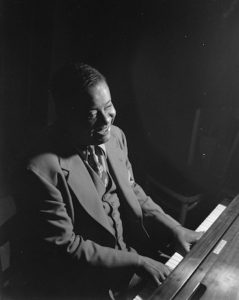
Art Tatum, 1946
Art Tatum, a Black pianist and one of the greatest jazz pianists of all time, was born on this date in 1909 in Toledo, OH.
Tatum was blind in one eye and visually impaired in the other. A child prodigy with perfect pitch, Tatum learned to play by ear, picking out church hymns by age three, learning tunes from the radio, and copying piano-roll recordings his mother owned. He developed an incredibly fast playing style without losing accuracy. Tatum drew inspiration from his contemporaries, James P. Johnson and Fats Waller, who exemplified the stride piano style, and the more "modern" Earl Hines.
During a 1932-33 tour with Adelaide Hall, Tatum made his first solo recordings, then worked as a soloist in various clubs throughout the United States and Europe. A major event in Tatum's meteoric rise to success was his appearance at a cutting contest in 1933 in New York City that included Waller, Johnson, and Willie "The Lion" Smith. Standard contest pieces included Johnson's "Harlem Strut" and "Carolina Shout" and Fats Waller's "Handful of Keys." Tatum triumphed with his arrangements of "Tea for Two" and "Tiger Rag" in a performance considered the last word in stride piano. Tatum's debut was historic because he outplayed the elite competition and heralded the demise of the stride era.
In 1943, he eventually formed a trio with guitarist Tiny Grimes and bassist Slam Stewart. In 1953, he began working with Norman Granz, which led to collaborations with Benny Carter, Ben Webster, and Roy Eldridge.
Tatum's technique was distinctive, and his hands glided effortlessly over difficult passages. Tatum played at astounding speed, with superb accuracy and timing, scintillating runs in which his fingers seemed to move hardly. His technique was remarkable, considering he drank prodigious amounts of alcohol when performing, yet his recordings are never sloppy. Tatum was an innovator in re-harmonizing melodies. Many of his harmonic concepts and larger chord voicings were well ahead of their time in the 1930s (except for their partial emergence in popular songs of the Jazz Age). They would be explored by bebop-era musicians 20 years later.
Tatum's fans included classical musicians such as pianist Vladimir Horowitz and conductor Leopold Stokowski. Horowitz was amazed at Tatum's technical command. Recordings that reveal his gifts include "The Art Tatum Solo Masterpieces," Vols. 1-8, and "The Tatum Group Masterpieces," Vols. 1-8.
Tatum was respected by fellow musicians and often thought of as super-human. His intricate and technically dazzling improvisational flourishes helped define the bebop lexicon's core with fleet-fingered runs and adventurous improvisations. He worked steadily in solo and trio settings, with occasional forays using larger groups, until his death on November 5, 1956.
Tatum posthumously received the Grammy Lifetime Achievement Award in 1989.
Image, William P. Gottlieb
Jazz: A History of the New York Scene
Samuel Charters and Leonard Kunstadt
(Doubleday, Garden City, N.Y., 1962) p.73
Jazz People
by Harry N. Abrams, Incorporated, New York
Copyright 1976
ISBN 0-8109-1152-3